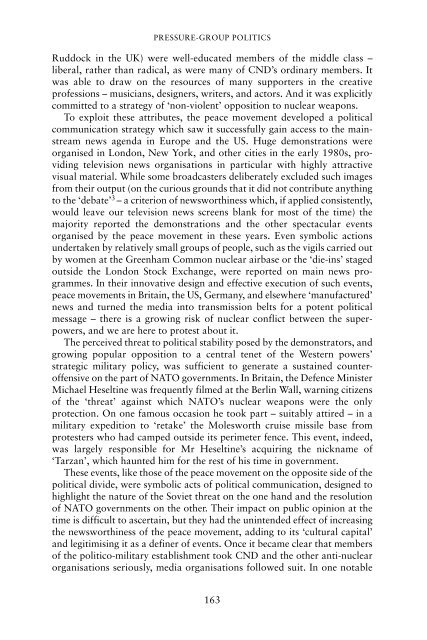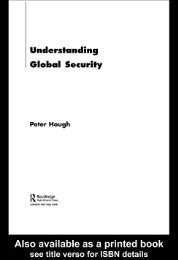20130412164339753295_book_an-introduction-to-political-communication
20130412164339753295_book_an-introduction-to-political-communication
20130412164339753295_book_an-introduction-to-political-communication
Create successful ePaper yourself
Turn your PDF publications into a flip-book with our unique Google optimized e-Paper software.
PRESSURE-GROUP POLITICS<br />
Ruddock in the UK) were well-educated members of the middle class –<br />
liberal, rather th<strong>an</strong> radical, as were m<strong>an</strong>y of CND’s ordinary members. It<br />
was able <strong>to</strong> draw on the resources of m<strong>an</strong>y supporters in the creative<br />
professions – musici<strong>an</strong>s, designers, writers, <strong>an</strong>d ac<strong>to</strong>rs. And it was explicitly<br />
committed <strong>to</strong> a strategy of ‘non-violent’ opposition <strong>to</strong> nuclear weapons.<br />
To exploit these attributes, the peace movement developed a <strong>political</strong><br />
<strong>communication</strong> strategy which saw it successfully gain access <strong>to</strong> the mainstream<br />
news agenda in Europe <strong>an</strong>d the US. Huge demonstrations were<br />
org<strong>an</strong>ised in London, New York, <strong>an</strong>d other cities in the early 1980s, providing<br />
television news org<strong>an</strong>isations in particular with highly attractive<br />
visual material. While some broadcasters deliberately excluded such images<br />
from their output (on the curious grounds that it did not contribute <strong>an</strong>ything<br />
<strong>to</strong> the ‘debate’ 3 – a criterion of newsworthiness which, if applied consistently,<br />
would leave our television news screens bl<strong>an</strong>k for most of the time) the<br />
majority reported the demonstrations <strong>an</strong>d the other spectacular events<br />
org<strong>an</strong>ised by the peace movement in these years. Even symbolic actions<br />
undertaken by relatively small groups of people, such as the vigils carried out<br />
by women at the Greenham Common nuclear airbase or the ‘die-ins’ staged<br />
outside the London S<strong>to</strong>ck Exch<strong>an</strong>ge, were reported on main news programmes.<br />
In their innovative design <strong>an</strong>d effective execution of such events,<br />
peace movements in Britain, the US, Germ<strong>an</strong>y, <strong>an</strong>d elsewhere ‘m<strong>an</strong>ufactured’<br />
news <strong>an</strong>d turned the media in<strong>to</strong> tr<strong>an</strong>smission belts for a potent <strong>political</strong><br />
message – there is a growing risk of nuclear conflict between the superpowers,<br />
<strong>an</strong>d we are here <strong>to</strong> protest about it.<br />
The perceived threat <strong>to</strong> <strong>political</strong> stability posed by the demonstra<strong>to</strong>rs, <strong>an</strong>d<br />
growing popular opposition <strong>to</strong> a central tenet of the Western powers’<br />
strategic military policy, was sufficient <strong>to</strong> generate a sustained counteroffensive<br />
on the part of NATO governments. In Britain, the Defence Minister<br />
Michael Heseltine was frequently filmed at the Berlin Wall, warning citizens<br />
of the ‘threat’ against which NATO’s nuclear weapons were the only<br />
protection. On one famous occasion he <strong>to</strong>ok part – suitably attired – in a<br />
military expedition <strong>to</strong> ‘retake’ the Molesworth cruise missile base from<br />
protesters who had camped outside its perimeter fence. This event, indeed,<br />
was largely responsible for Mr Heseltine’s acquiring the nickname of<br />
‘Tarz<strong>an</strong>’, which haunted him for the rest of his time in government.<br />
These events, like those of the peace movement on the opposite side of the<br />
<strong>political</strong> divide, were symbolic acts of <strong>political</strong> <strong>communication</strong>, designed <strong>to</strong><br />
highlight the nature of the Soviet threat on the one h<strong>an</strong>d <strong>an</strong>d the resolution<br />
of NATO governments on the other. Their impact on public opinion at the<br />
time is difficult <strong>to</strong> ascertain, but they had the unintended effect of increasing<br />
the newsworthiness of the peace movement, adding <strong>to</strong> its ‘cultural capital’<br />
<strong>an</strong>d legitimising it as a definer of events. Once it became clear that members<br />
of the politico-military establishment <strong>to</strong>ok CND <strong>an</strong>d the other <strong>an</strong>ti-nuclear<br />
org<strong>an</strong>isations seriously, media org<strong>an</strong>isations followed suit. In one notable<br />
163
















